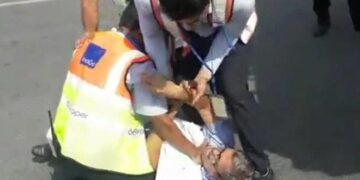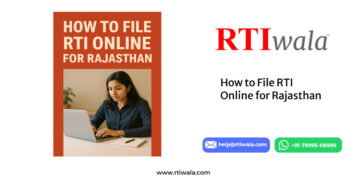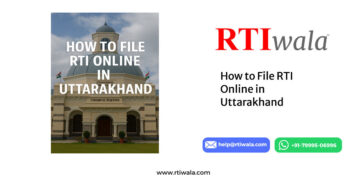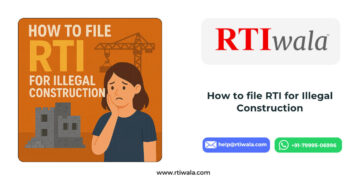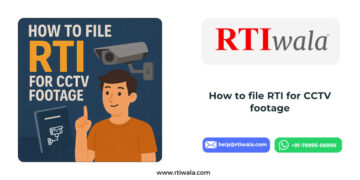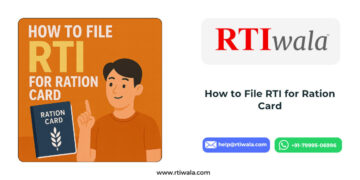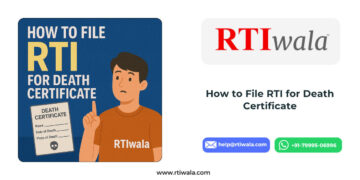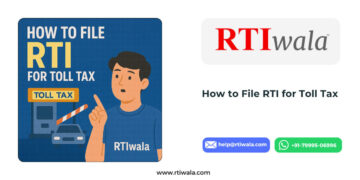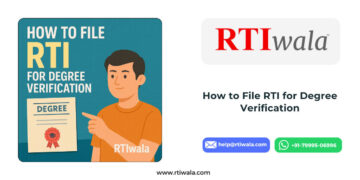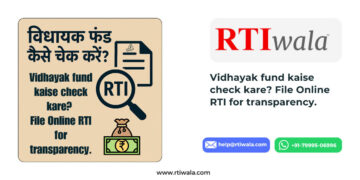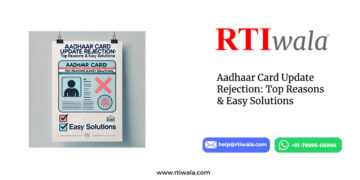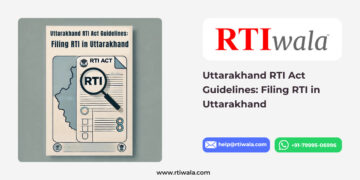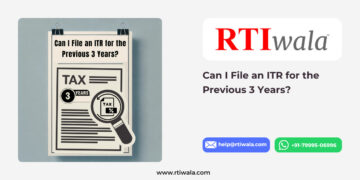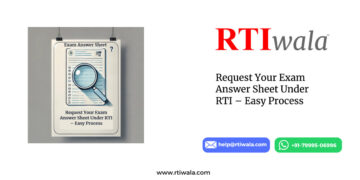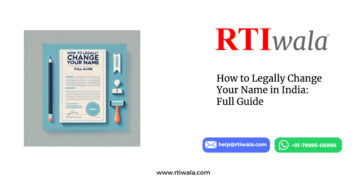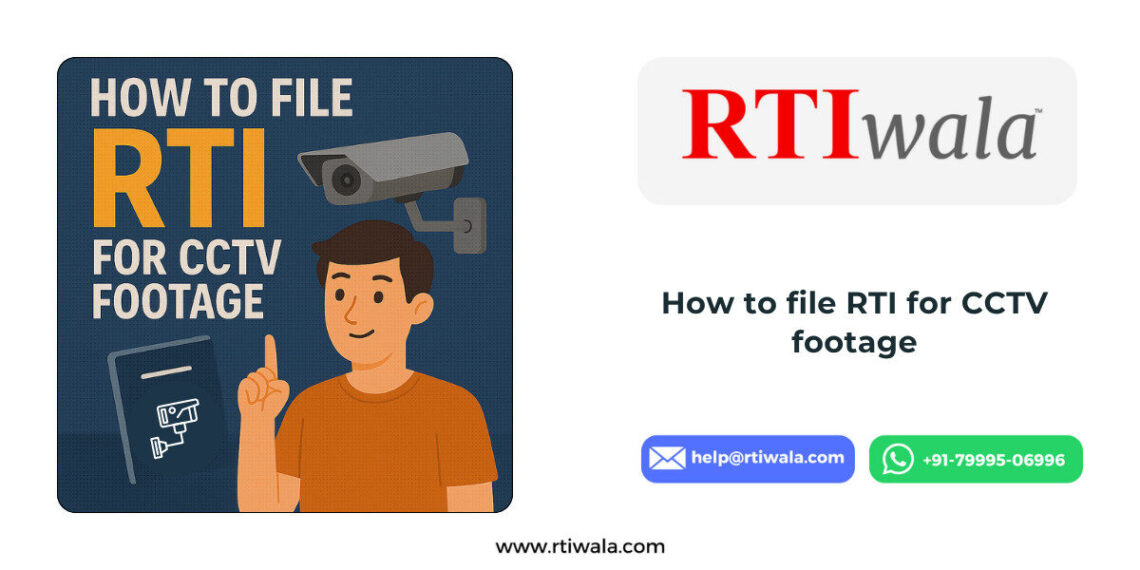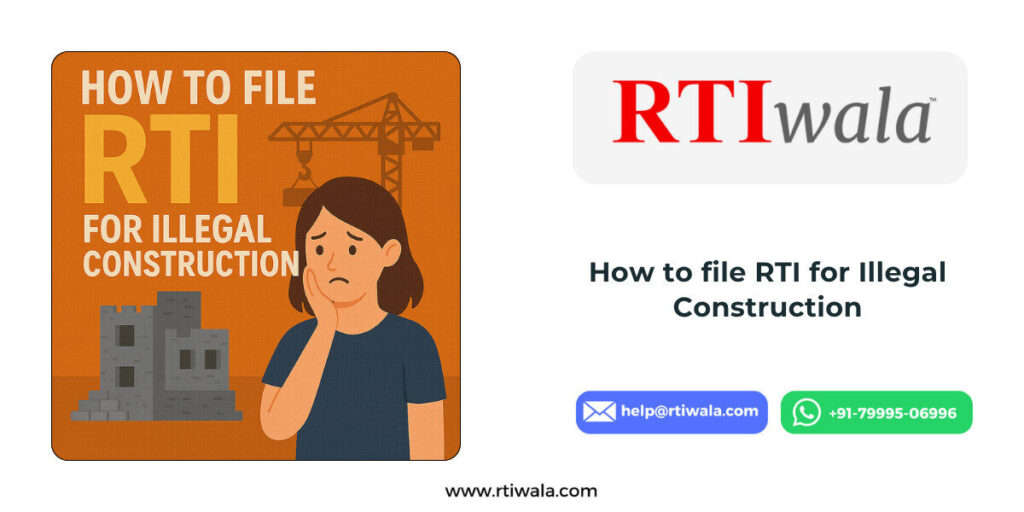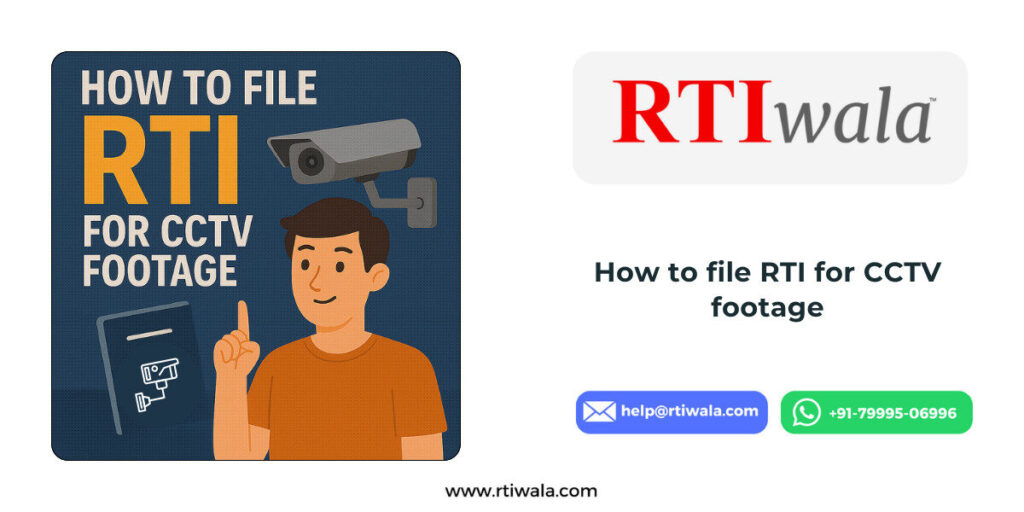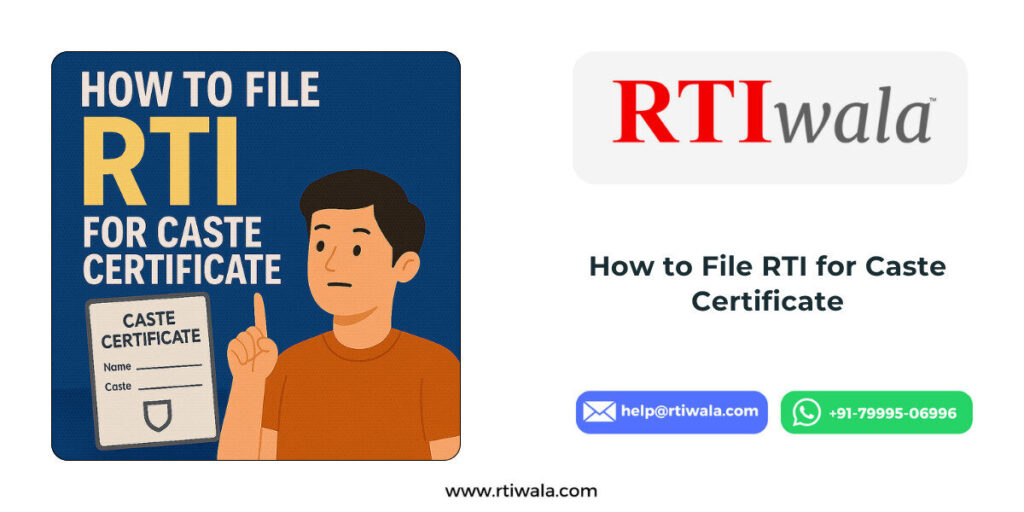Table of Contents
- Can CCTV Footage Be Obtained Under the RTI Act?
- Step-by-Step: How to File RTI for CCTV Footage Online and Offline
- CCTV Footage of Police Station Under RTI
- How Can I Get Street Camera Footage
- Documents Required & Eligibility to Get CCTV Footage Under RTI Act
- Common Mistakes to Avoid While Requesting CCTV Footage Through RTI
- CCTV Rules and Regulations in India
- What to Do If Your CCTV Footage RTI Is Rejected or Ignored
- RTIwala Expert Tips: Get CCTV Footage Legally and Safely in 2025
Can CCTV Footage Be Obtained Under the RTI Act?
Yes — CCTV footage can be obtained under the RTI Act, provided the footage:
- Exists and has not been deleted (most CCTVs overwrite every 7–30 days).
- Does not contain sensitive information that affects security or privacy of others.
- Is held by a public authority (police station, municipal corporation, transport department, metro authority, government office, school, hospital, etc.).
As per Section 2(j) of the RTI Act, a citizen has the right to “inspect” or obtain “certified copies” of records, and CCTV footage qualifies as a recorded video document.
However, authorities may blur faces or share only the relevant portion to protect privacy under Section 8(1)(j).
RTI Guidelines on CCTV Footage
Public Authorities must maintain CCTV footage as per:
When Authorities Can Refuse
Under RTI, CCTV footage may be denied if:
- The footage contains third-party personal data (Section 8(1)(j)).
- Footage is linked to an ongoing investigation (Section 8(1)(h)).
- Footage no longer exists due to automatic overwrite.
- Revealing it may threaten public safety (Section 8(1)(a)).
When Authority MUST Provide Footage
CCTV footage must be given when:
- The requester is visible in the footage (self-related information – Section 2(j)(ii)).
- The incident concerns public safety, accident, theft, harassment, or misconduct.
- The footage is from a public place (road, footpath, public building entrance).
- The requester provides exact date, time & location, making the search feasible.
How to File RTI for CCTV Footage Online (Detailed Guide)
Filing an RTI for CCTV footage is simple, but it must be drafted very accurately, otherwise authorities reject it due to privacy rules, wrong jurisdiction, or missing details.
Follow this step-by-step guide to increase your success rate.
Identify the Correct Public Authority
The first and most critical step is finding out who owns the CCTV camera whose footage you need. RTI will fail if the application goes to the wrong department.
Common CCTV ownership examples:
- Police Department / Traffic Police:
Cameras at intersections, roads, highways, accident spots, crime locations. - Municipal Corporation / Nagar Nigam:
Markets, footpaths, parks, public squares. - State Transport / Metro Authorities:
Metro stations, bus stands, bus depots. - Government Schools, Colleges, Offices:
Classroom, lab, campus, and entrance CCTV. - Hospitals / PHCs / CHCs:
OPD area, corridors, gate CCTV. - Road & Building Department:
Highways, toll plazas, government buildings.
If you are unsure
File your RTI to the nearest Police Station (SHO/PI) and request them to transfer it under Section 6(3) to the correct department.
This ensures your request is not rejected.
Draft a Clear, Specific, Legally Strong RTI Application
Your application must be specific, otherwise the PIO will reject it saying:
“Footage cannot be traced due to vague details.”
Include these MUST-HAVE details:
- Exact location
(e.g., “CCTV Camera installed at XYZ Road, opposite ABC Store, Gate No. 2”) - Exact date
(DD/MM/YYYY) - Exact time range
(e.g., 2:45 PM to 3:10 PM) - Nature of incident
(accident, theft, harassment, assault, property damage, etc.) - Your presence in footage (if applicable)
This removes “third-party privacy” objections. - Urgent preservation request
CCTV gets overwritten in 7–30 days.
Suggested RTI Lines:
“Kindly preserve and provide the CCTV footage for the date and time mentioned above before auto-deletion, under Section 2(j) of the RTI Act.”
“If full disclosure is not possible, please provide the relevant portion where the incident is captured.”
Option 1: File CCTV RTI With RTIwala (Highest Success Rate)
Best for busy users, and sensitive CCTV matters (accident, theft, harassment, fight, illegal activity).
RTIwala offers the safest, most powerful, and legally strong way to file RTI for CCTV footage because:
1. RTIwala files the RTI anonymously in your place (your identity stays protected).
Your name never appears. RTI is filed under the name of an RTIwala-authorised advocate —
this increases the reply chances 2×–3× because authorities take advocate-filed RTIs more seriously.
2. Expert Legal Drafting (Legally Strong Sections)
RTIwala drafts:
- Urgent preservation request
- Correct legal sections
- Proper CCTV request format
- Clear timeline & location details
- Privacy-compliant wording (avoids easy rejection)
A normal person can’t draft all this correctly — that’s why most self-filed CCTV RTIs get rejected.
3. Complete End-to-End Support
RTIwala handles 100% of the work, including:
- Drafting
- Filing
- Pushing for replies
- Handling objections
- First Appeal (if PIO denies or delays)
- Follow-up until response is received
You just need to share the location, date & time of the incident.
4. 93% Success Rate (India’s Highest for CCTV RTIs)
Because:
- Advocates file the RTI
- No drafting mistakes
- Correct authority selection
- Strong follow-up
- First Appeal included
RTIwala WhatsApp (Direct Filing Help)
+91-7999-50-6996
If you want the highest chance of getting CCTV footage, this is the best and safest option.
Option 2: Online RTI Filing (Good, But Limited)
You can file RTI online using State or Central portals.
However, online filing has limitations:
- No legal drafting assistance
- No anonymity — your personal details become public
- No preservation line → footage gets deleted before 30 days
- No follow-up or First Appeal support
- Easy for the PIO to reject by citing privacy or vagueness
Where to File:
- Central Govt: https://rtionline.gov.in
- State portals (Delhi, Maharashtra, Rajasthan, Karnataka, UP, Telangana etc.)
Steps:
- Write your own RTI
- Select department
- Pay fee
- Submit
Success rate: 30%–40% (for CCTV cases)
Option 3: Offline RTI Filing via Speed Post (Basic, Slowest)
This method works, but has the lowest success rate because:
- You must draft your own RTI
- Authorities often misplace physical letters
- No tracking system
- Response takes 35–50 days
- High chance of rejection due to technical errors
You need to:
- Write RTI on paper
- Attach IPO
- Send via Speed Post to PIO
- Wait for reply
Success rate: 20%–25%
CCTV Footage of Police Station Under RTI
You can get CCTV footage of a police station by filing an RTI with the station’s Public Information Officer (PIO). Mention the exact date, time, and area like the main gate or reception. If the footage relates to you or an important incident, the PIO can provide it unless it affects an investigation or security. Always request urgent preservation since police CCTV gets auto-deleted quickly
How Can I Get Street Camera Footage
To get street or road CCTV footage, file an RTI with the Traffic Police or Municipal Corporation responsible for that location. Clearly mention the road, landmark, date, and time of the incident. If the request is specific and justified—like accident, hit-and-run, or dispute—they can share the relevant clip. Add a preservation request because street cameras overwrite footage in a few days.
Documents Required & Eligibility to Get CCTV Footage Under RTI Act
You must be an Indian citizen to file an RTI. Keep these documents ready:
- Valid ID proof (Aadhaar, PAN, Voter ID)
- Details of location, date, and approximate time of the footage
- Proof of involvement or reason for requesting footage (if applicable)
Note: Private entities are not bound by RTI unless they receive substantial government funding or perform public duties.
Common Mistakes to Avoid While Requesting CCTV Footage Through RTI
Asking for vague or continuous footage (e.g., “entire week’s CCTV”)
Not mentioning the exact date and time window
Sending RTI to the wrong department or private entity
Forgetting to include the fee or applicant details
Expecting CCTV footage older than the system’s storage limit (usually 30 days)
To avoid rejections, get your RTI drafted by experts through RTIwala’s Custom Drafting Service.
CCTV Rules and Regulations in India
CCTV usage in India is governed by a mix of guidelines under the IT Act 2000, Data Privacy Principles, and multiple government notifications on surveillance systems. Even though there is no single “CCTV Act,” the law is clear about how CCTV footage should be stored, shared, and protected.
In India, every CCTV owner—whether it’s a shop, housing society, road authority, or police station—must ensure proper data handling, and citizens have the right to request footage if it concerns them.
Here are the key rules you must know:
1. Mandatory Storage Period
Most government authorities follow the 30-day minimum storage rule.
But sensitive places like airports, police stations, toll plazas, and hotels may keep footage longer (60–90 days).
2. CCTV Must Not Violate Privacy
Cameras cannot be placed in:
- Bathrooms
- Trial rooms
- Bedrooms
- Private office cabins
- Changing rooms
Doing so is a punishable offense.
3. Notice Boards Are Mandatory
Any public or private place with CCTV cameras must display:
“This area is under CCTV surveillance.”
Not mentioning this makes footage collection questionable.
4. Footage Must Be Given for Legitimate Purposes
Authorities and private establishments must provide footage when:
- The requester appears in the footage
- It is needed for accident, theft, or harassment evidence
- It is demanded by police or court
Still, many places deny footage — which is where RTI becomes the strongest way to access it.
5. Cybersecurity Compliance
CCTV feeds must be protected from hacking by using:
- Encrypted systems
- Secure passwords
- Restricted access permissions
6. Public CCTV (Police/Traffic/Smart City Cameras)
These fall under government departments, so citizens can seek footage using RTI, especially for:
- Road accidents
- Hit-and-run cases
- Crime incidents
- Public safety issues
Government must justify any refusal strictly under RTI Act exemptions.
What to Do If Your CCTV Footage RTI Is Rejected or Ignored
If no reply is received within 30 days or your request is denied:
File a First Appeal with the department’s Appellate Authority.
Escalate to the Information Commission if still unresolved.
File RTIwala’s Follow-up Add-ons to ensure your appeal is filed professionally and tracked till resolution.
RTIwala Expert Tips: Get CCTV Footage Legally and Safely in 2025
Always mention specific date, time, and location details.
File Anonymous RTI for sensitive cases involving police or public offices.
Avoid asking for personal or third-party footage (it’s exempt under Section 8(1)(j)).
Keep copies of receipts and postal acknowledgments.
Want legal clarity and strong RTI drafting support?
Contact: +91-7999-50-6996
Visit: www.rtiwala.com
FAQ
1. How to get security camera footage from a store?
You can request the store manager/owner directly with the date, time, and purpose of your request. Most stores provide footage only if you were involved in an incident. If they refuse, you may approach the local police or use RTI if the store is a government-owned establishment.
2. How to obtain CCTV footage from police?
Police provide CCTV footage only if it is part of an FIR, complaint, or investigation. You must submit a written request to the Station House Officer (SHO). If they delay or deny without proper reason, you can file an RTI seeking a copy of the footage or the status of your request.
3. How to obtain CCTV footage after an accident?
Visit the nearest police station and submit an application with accident details (date, time, location). Police will retrieve footage from nearby cameras and provide it for investigation purposes. If not provided, you can ask for the footage or status through RTI.
4. How to get CCTV footage of a car accident?
You can request it from:
- The police station handling your case,
- Nearby shop owners, or
- Authorities managing public cameras.
If anyone refuses without a valid reason, RTI can help you get official confirmation or the reason for denial.
5. How to get CCTV footage of a road?
Road CCTV footage is normally owned by municipal corporations, traffic police, or Smart City authorities. You must apply to the respective department. If ignored, you can file an RTI seeking footage or the action taken report.
6. How to get CCTV footage from police?
Submit a written request to the police station where the incident occurred. Provide exact time and location. If they deny due to an ongoing investigation, they must communicate it in writing. You can use RTI to obtain that written response.
7. How to get CCTV footage from a DVR?
If the DVR belongs to a private person/business, request them directly. If they refuse and the footage is needed for legal reasons, police can seize/collect the DVR data. You can also ask the authority (if government-owned) using RTI.
8. How to get CCTV footage from a council?
For municipal council cameras, submit an application to the Municipal Commissioner’s office or the IT/Surveillance department. If they do not respond, you can request the footage or the status under RTI.
9. How to get a copy of CCTV footage?
You must approach the camera owner (store, police, municipal authority). Provide a reason and exact timestamps. If access is denied without justification by a government agency, you can file an RTI demanding the copy or the reason for denial.
10. Is CCTV footage available under the RTI Act?
Yes, CCTV footage can be provided under the RTI Act if the camera is owned by a government body and the footage does not:
- Affect national security,
- Interfere with ongoing investigations, or
- Reveal personal information of third parties without public interest.
If denied, the PIO must cite a proper section (like Section 8).
11. How to file an RTI for CCTV footage in India?
To file an RTI for CCTV footage, identify the correct public authority (police, municipal body, traffic department, etc.), clearly mention the date, time, and location, and submit your application through the RTI Online Portal or by post with fee. RTIwala offers expert drafting, ensuring accuracy and higher success rates.
12. Can I request CCTV footage from a police station under the RTI Act?
Yes, you can. However, footage may be denied under Section 8(1)(h) (hindrance to investigation) or Section 8(1)(j) (privacy) if it involves sensitive or third-party information. The police must justify the denial in writing.
13. What happens if CCTV footage is deleted before I file the RTI?
If the footage is deleted (usually after 7, 15, or 30 days depending on storage policies), the authority is not obligated to provide it. Always file your RTI as soon as possible and mention urgency to avoid data loss.
14. Can I get CCTV footage from private establishments through RTI?
Generally, no. Private establishments are not covered under RTI unless they are government-funded or regulated by a public authority. For purely private entities, you must request footage directly from them or lodge a police complaint.
15. Why should I use RTIwala for filing RTI for CCTV footage?
RTIwala provides:
- Legally strong, professionally drafted RTI applications
- Correct authority mapping to avoid rejection
- Higher success rates due to precise drafting
- Anonymous RTI filing for privacy-sensitive cases
This significantly reduces rejection chances and speeds up the response.
16. What to do if my RTI request for CCTV footage is rejected or unanswered?
You can file a First Appeal with the Appellate Authority if the RTI is ignored or wrongly denied. If the delay continues, escalate to the Information Commission. RTIwala’s Follow-Up Add-Ons help you draft appeals quickly and effectively.
17. How long does it take to receive CCTV footage through RTI?
Public authorities must respond within 30 days. In emergency scenarios involving life or liberty, the response must be given within 48 hours as per Section 7(1) of the RTI Act.
18. Where can I file an RTI for CCTV footage online?
Use:
- RTI Online Portal (for central govt)
- State RTI portals (for state departments)
For expert drafting and privacy protection, you can also file through RTIwala.com, which handles drafting, filing, follow-up, and appeals.



